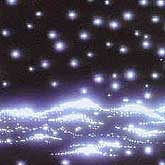Jumping Starlight
 'Twinkle, twinkle, little star, how I wonder what you are,' says the song by Jane Taylor. But stars don’t really twinkle; their light reaches the earth in a steady way. Why then do we see them flickering around in the sky? The answer is in the atmosphere.
'Twinkle, twinkle, little star, how I wonder what you are,' says the song by Jane Taylor. But stars don’t really twinkle; their light reaches the earth in a steady way. Why then do we see them flickering around in the sky? The answer is in the atmosphere.
The air in the atmosphere is turbulent. That means there are different layers of air with different temperatures; some hot, some cooler. Hot air is less dense than cooler air. The light of the stars bends when it goes from a less dense part of the atmosphere to a denser one. Think about a straw in a glass of water. The straw seems to bend when it enters the water, but actually light is bending as it goes from one medium (air) to another (water). This behavior of light is called refraction.
Little packets of air, called cells, move around in the atmosphere. Starlight bends a little each time it goes through one of these cells. When you see a star from the ground, its light has crossed hundreds of cells in the sky, refracting in random directions - so the image of the star appears to jump!
About the Author
Diego Pineda
 Diego holds a master's degree in science and technology journalism from Texas A&M University and work as a science writer for Immunizations for the Public Health (I4PH), a Texas-based nonprofit corporation that provides information services on vaccines and immunizations. He enjoys
writing about genetics, bioethics, and physics -- both in English or
Spanish.
Diego holds a master's degree in science and technology journalism from Texas A&M University and work as a science writer for Immunizations for the Public Health (I4PH), a Texas-based nonprofit corporation that provides information services on vaccines and immunizations. He enjoys
writing about genetics, bioethics, and physics -- both in English or
Spanish.


